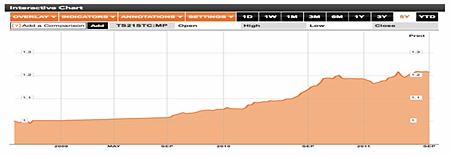The asset-backed solution
The other alternative is to identify assets with similar investment characteristics to cash but which produce higher returns. Asset-backed investments generally provide a reasonable level of security depending on the underlying assets in question although in many cases liquidity is compromised.
There are some exceptions to this including our own current preference. This is the Two Seasons 21st Century Fund which consists of tangible assets such as residential and commercial property or the assets of businesses such as plant, machinery or stock. The levels of security are determined by the price stability of the underlying asset. Residential property is generally the preferred security. In the safest and most liquid asset-backed investments, the ability of the underlying asset to source alternative funding is a key factor in ensuring an acceptable level of liquidity.
 Bloomberg
Bloomberg
The actual return on the fund is not in any way dictated by the returns or income of the asset itself which is merely held as the security if the interest and/or capital payment obligations to the fund are impaired in any way. This is similar to the way that building societies and credit unions issue loans using depositors’ funds and take security against these. However, the main differences are that the funds do not leverage their exposures, so the levels of security held by the funds are much higher than those generally required by most building societies and credit unions. Also the underlying quality of the credit issued by the funds is a much higher calibre than most credit institutions yet the resultant returns are significantly higher.
Conclusion
There has never been such a difficult period for investors and analysts to ‘join the dots’. The risk on/off phenomenon is the manifestation in capital markets of the battle between economic fundamentals and the artificial effects of intervention. The massive debt levels of households, the banking sector and government debts are slowly but inevitably strangling the economic system. This is not a short-term phenomenon nor is any quick fix likely – hard, painful decisions are required but are unlikely to be forthcoming. Economists can only try to explain what is happening while investors need to play the card that they have been dealt. If they follow the conclusions of this guide, we expect investors to significantly outperform.
Political factors rather than fundamental factors currently drive markets but the artificial recovery manufactured by prolonged distortion of economic rules will ultimately have to face reality.
Central bank policies so far have generally taken the exact opposite path to the one required to deal with the economic downturn. This course of action is leading to another, larger crisis down the road.
Central banks and international organizations have used specious justifications and distorted precedents to justify their actions. Academic research is distancing itself from this and appears increasingly uncomfortable with the adopted policies.
Last year, and for the last decade, it has been vital to understand the economic context in order to achieve best risk-adjusted returns. The global economy is in a ‘winter’ phase.
The “new normal” – slow economic growth, increased volatility and disappointing investment returns – seen in 2011 is a taste of what is to come.
Winter gives rise to counter trend relief rallies in risk assets but investors who tactically exploit this need to be careful not to get caught “picking up Nickels in front of bulldozers”.
Investors who study economic history will be able to better anticipate the pending calamity than those who have blind belief that the unprecedented experiment currently being conducted by central bakers can, and will, change the essential nature of economic cycles.
The mess that led to the credit crunch and the GFC has never been tidied away or dealt with – only swept under the carpet.
Europe is a disaster waiting to happen at some point, even if the can could be kicked further down the road.
If they do not get things right then China may be a greater problem than Europe. Strategic asset allocations should be to cash, gold and fixed interest.
As the end of winter gets closer each day, investors need to be aware of the potential need to exit these positions in the future but winter is likely to persist for a number of years.
Cash has less potential downside than gold or bonds but cash returns are extremely meagre. It is vital to maximize returns from cash holdings without compromising security or liquidity.
The two keys to enhancing cash returns are either to exploit long term currency trends or to identify assets with higher returns which also offer cash characteristics.
Currency trends have been, and continue to be, most successfully implemented by Martin Gray within portfolios such as Special Situations, Strategic and Rhodium, all of which have moved from exploiting Yen strength to investing in Asian currencies.
The few asset-backed investments, such as 21st Century, that provide adequate security and liquidity provide the best cash equivalent investments.
Whilst the environment is challenging for investors, it is not impossible to stay ahead of the curve and keep your future in your own hands.
End.
| The above data and research was compiled from sources believed to be reliable. However, neither MBMG International Ltd nor its officers can accept any liability for any errors or omissions in the above article nor bear any responsibility for any losses achieved as a result of any actions taken or not taken as a consequence of reading the above article. For more information please contact Graham Macdonald on [email protected] |




